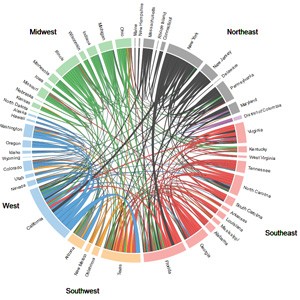A couple of my favorite annual corporate releases are coming out the first week of 2012: the annual migration studies produced by large moving companies. United Van Lines’ migration study is expected out Jan. 2, and Atlas Van Lines will release its annual survey on Jan. 3, a spokeswoman said.
Based on where they’re moving goods for customers, the studies report on which states experience the most inbound residents, which experience the most outbound moves, and other interesting information such as the volume of moves.
You can use these reports as launching pads for a variety of business and economy stories. While not all of the moves likely are a result of jobs trends (people move for other reasons such as retirement, marital-status changes, higher education, and simple preference), the reports are helpful in spurring an analysis of your local economy and its pros and cons. Have major employers arrived or departed? Are workers following departing employers to jobs elsewhere? Are retirees opting to live elsewhere due to housing prices, income-tax rules or other factors? What do employers, economic development agencies and municipalities in your region expect in 2014?
Another story I’ve long wanted to see done is a follow-up with expatriates who depart one state for perceived greener pastures elsewhere. For example, my state, Michigan, sent a lot of people to Southern states such as Texas and North Carolina. I would like to read accounts of what some specific families have experienced, pro or con, within a couple of years of moving. What have they found about cost of living, job opportunities for breadwinners, as well as job opportunities for, say, teens, or adults in the household who wish to work part-time? What about educational opportunities and costs, the price of housing and car insurance, even things such as heating and cooling expenses. Did the move end up making as much sense — economically and emotionally — as it seemed to when it took place.
One really cool way to see who’s going where is this migration-patterns map from Wired. It’s kind of like one of those airline-routes maps in the in-flight magazine, with overlapping lines swooping from point to point. But thanks to this one’s interactivity, you can click on your state and get a set of lines that illustrate top states exchanging people with your home state. Fascinating. You also can find data at the U.S. Census Bureau’s Geographic Mobility/Migration portal.
Corporate relocation policies and perks.
Atlas separately publishes a corporate-relocation survey; while it’s not as hot off the press as the migration study, you can peruse it for background. Are employers in your region willing to pay moving costs and offer other incentives — mortgage assistance, temporary housing — to lure talent? How have policies evolved since the recession? What about outbound — are local residents heading elsewhere for jobs packing a U-Haul or getting white-glove treatment from future employers?
Moving firms.
Don’t overlook the possibilities in moving-company stories, as well. In addition to cross-country movers such as United and Atlas, you’ve got local and regional chains or franchises such as Two Men and a Truck; how are they faring, as an indicator of mobility and economic activity? What about specialty services such as those that help retiring Baby Boomers — or those moving into assisted living — relocate and downsize at the same time? Again, how does demand for their services reflect consumer demographics and economic behavior in your region?











